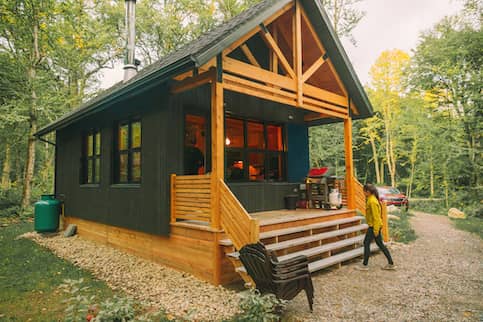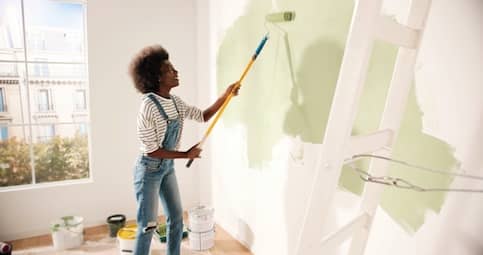How Does Sweat Equity Work In Real Estate?

Buying and renovating a home can be a costly process. But you can reduce these costs by handling at least some of the renovations on your own, without the help of carpenters, electricians, drywallers and other contractors. This is known as sweat equity: You’re doing the work yourself that you would ordinarily pay others to take on.
The challenge? Renovating a home isn’t easy. And if you’re not already skilled with plumbing, electrical systems and drywalling, you might find the DIY process to be a daunting one.
But if you’re ready to wield the hammers, saws and wrenches yourself, you could save thousands of dollars.
What Is Sweat Equity In Real Estate?
Sweat equity is the time and effort you put into handling property repairs and renovation work on your own. You can put sweat equity into your primary home, saving yourself thousands of dollars in contractor fees, or you could take on your own labor after you purchase an investment property.
Putting sweat equity into an investment property could pay off: Because you’ll spend less to renovate the property, you could earn a larger profit when you sell it.
It’s important to be realistic, though. You might be able to install a new front door, paint your interior rooms and install new shelving and kitchen cabinets on your own. But you might not be skilled enough to rewire an aging electrical system or build a new master bathroom. Some projects – such as electrical work – could even be dangerous if you aren’t skilled enough.
But even doing smaller jobs on your own could save you thousands of dollars. Take an honest look at your home and decide where to judiciously apply your sweat equity. And don’t take on work that you might not be able to handle. That might end up costing you more in the long run.
Sweat Equity For Homeowners
Own a home? Sweat equity can help boost the value of the property. If you install new cabinets in your kitchen, build a walk-in closet in your bedroom or replace your windows with energy-efficient models, you can increase the value and resale appeal of your home.
This helps increase your home equity. This is the difference between what you owe on your mortgage and what your home is worth. If your home is worth $350,000 and you owe $200,000 on your mortgage, you’ve built $150,000 of equity.
You can then borrow against that equity in the form of home equity loans or a cash-out refinance.
With a home equity loan, you can borrow a portion of your equity – up to 90% – and receive a lump sum payment. You then pay that money back each month, with interest, like you do with your primary mortgage. You can use your home equity loan money for whatever you’d like, though many homeowners use it to finance renovations or repairs to their residence.
In a cash-out refinance, you refinance for more than what you owe on your mortgage. You then use the extra money for whatever you want, including home renovations.
Say you owe $200,000 on your mortgage. You might refinance to a new home loan of $250,000, then use the extra $50,000 for whatever you’d like. Just remember: You’ll have to pay back all of what you borrowed with regular monthly payments. If you refinance for more than what you owe on your existing mortgage, you’ll end up paying more in the long run.
If you have more equity in your home, you’ll also walk away with a bigger profit when it’s time to sell. DIY renovations can help make this happen.
Sweat Equity For Real Estate Investors
Sweat equity is a common tool that real estate investors rely on to earn more money when they buy and then sell or rent a property.
Investors want their investment properties to increase in value as they own them. One way to boost the odds of this happening is for these investors to renovate the homes they buy. They can then sell them for a higher profit. If they choose to rent the properties, they’ll be able to charge higher rent after improving or renovating them.
Sweat equity reduces the cost of these improvements, making it easier for investors to earn a profit. Investors who can upgrade kitchens and bathrooms or add landscaping to their properties on their own will eliminate thousands of dollars in contractor costs. They’ll then have to earn less when selling or renting to enjoy a solid profit.
See What You Qualify For
Home Purchase
Home Refinance
Tap Into Equity
How To Calculate Sweat Equity
How much is sweat equity worth? That depends on your home’s current market value and the renovations you are tackling.
1. Put Together Your Numbers
It can be difficult to determine the value of sweat equity until a renovation is complete. But you can at least calculate a rough value of what your DIY skills can bring to a project by knowing certain numbers:
- Estimate your home’s current market value: The market value of your home is an estimate of how much it would sell for in today’s market. You can get a more accurate market value by hiring an appraiser, who will compare your homes to similar residences in your neighborhood. That isn’t free, though, and you can expect to pay about $500 for an appraisal. You can also estimate your home’s value on your own by looking up your address on popular real estate websites, many of which will provide an estimated market value. For this example, let’s say that your home has a current market value of $300,000.
- Estimate your home’s appreciation: Historically, home values have risen annually by 5% or 6%, according to research from the Federal Reserve Bank of St. Louis. After 1 year, then, you could expect your home to increase in value by $15,000 – $18,000, boosting your property’s market value anywhere from $315,000 – $318,000. Note, though, that homes aren’t guaranteed to increase in value by 5% or 6% every year. They could lose value in a given year or they could increase in value by even more. Recent housing market volatility, for instance, has caused home values to spike by 20% or more in a year.
- Calculate the total appreciation of the home’s value after the work is completed: Next, estimate how much value your home renovation will bring to your property. This will vary depending on the project you are taking on. Generally, renovations such as kitchen and bathroom remodeling projects or adding space such as an extra bedroom bring the greatest return. Let’s say that you are taking on a minor kitchen remodel, one that requires replacing outdated kitchen cabinets and countertops and adding new appliances. Such a remodel brings an average return of $20,125, according to Remodeling Magazine’s 2022 Cost Vs. Value Report. That would boost your $300,000 home’s market value to $320,125. If you add the $15,000 – $18,000 in expected appreciation, your home could be worth $335,125 to $338,125. Remember, though, that this value will typically increase each year, so the longer you hold onto the property, the more it is likely to appreciate.
- Estimate the cost of materials, additional labor and other expenses required to complete the project: A home renovation, even when you do the work, isn’t free. You’ll have to factor in the cost of materials. Remodeling Magazine says that the cost of a minor kitchen remodel averaged $28,279 in 2022. That figure, though, includes the cost of labor. To complete your minor kitchen remodel on your own, maybe you’ll just pay around $15,000. However, the true cost will depend on your skill, the design and the products, appliances and finishes you use.
2. Apply The Formula
Now that you know your numbers, you can estimate how much money you’ll save through your sweat equity.
Step 1. Multiply your home’s current market value by the percent increase in value due to changes in the real estate market. Let’s say your home worth $300,000 increases in value in your first year of owning it by 5%. That gives you a home worth $315,000 after 1 year.
Step 2. Add the cost of materials and other expenses required to complete the project. Let’s use our example above and say that you spent $15,000 on a minor kitchen remodeling project.
Step 3. Take the cost of your renovation and subtract it from the total appreciated value of the home after the work has been completed. Let’s estimate that your kitchen remodel boosts your home’s value by $21,000. After 1 year, your home, factoring in the increase in value from the kitchen project and 1 year of price appreciation, would be worth $336,000. Your renovation work accounted for $21,000 of this appreciation. Subtract the $15,000 you spent on the renovations, and your sweat equity was worth $6,000. This isn’t the end of your sweat equity’s value, though. Because you increased the base value of your home, those expected average 5% – 6% annual price appreciations will generate more value each year.
Decide If Sweat Equity Works For You
Is your sweat equity worth the time and effort you put into it? That depends on how much extra value your renovation brings to your home. Let’s say you convert a bedroom in your home to a master bedroom suite. If this boosts your home’s value by $30,000 and you only spend $15,000 on the project, your sweat equity is $15,000, or $30,000 minus $15,000. That’s a pretty good return.
But what if you add a backyard deck, a project that costs $5,000? If that deck only boosts your home’s value by $7,000, your sweat equity was worth just $2,000, or $7,000 minus $5,000. That might not be enough of a return to justify the time you spend on the renovation.
Take the first step towards buying a house.
Get started today to see what you qualify for.
How To Put Sweat Equity To Work As A Real Estate Investor
If you are a real estate investor planning to flip a home, you’ll have to do more research to determine how much sweat equity you want to put into a project. Flipping a home is a business, and it requires careful planning.
1. Decide What Kind Of Sweat Equity You Want To Apply
First, determine what kind of sweat equity you’d like to put into your investment properties. You might think of sweat equity as installing drywall, refinishing hardwood floors and replacing outdated countertops and cabinetry. But sweat equity can take on many different forms.
For instance, researching and identifying income-producing investment properties on your own without the help of outside analysts is a type of sweat equity that can save you money. Maybe you are a lawyer. Sweat equity would include handling the legal aspects of buying an investment property, such as drawing up contracts, without paying for an attorney. If you are an accountant or financial planner, sweat equity includes calculating budgets and balancing your books on your own. Sweat equity is any task that you do on your own that will reduce your labor costs. It doesn’t only mean physical labor.
2. Determine Additional Costs
When calculating the costs of renovating an investment property, you’ll need to factor in the expenses that you aren’t covering with sweat equity. This includes the cost of the contractors you hire, the materials you need and the time it takes to finish your renovations. Don’t forget, too, the cost of any permits you might need to acquire from your local municipality.
3. Find Investors
Depending on how much you are willing to spend on a property, you might need additional investors to help cover the costs. This is also a chance to tap more sweat equity. Maybe one of your potential investors is a carpenter. If this investor is willing to perform some of the carpentry work on the project either for free or a lower cost, you could save money on renovation costs.
To attract investors, you might need to create a presentation explaining how these investors can contribute sweat equity and how the work or expertise they provide can help boost the odds of all investors turning a profit on the real estate investment.
4. Create A Sweat Equity Agreement
If you do take on additional investors, make sure to create a sweat equity agreement. This is a written document signed by all investors that lists what each investor will bring to the deal (both financially and in terms of sweat equity), the ownership percentage each investor will hold and the percentage of the profits and income that investors will receive.
For example, a sweat equity agreement might state that an investor who is an electrician will handle the rewiring of an investment property while an investor with legal experience will draw up any contracts that tenants of the property will sign.
5. Apply For Additional Financing
You might need to apply for financing to fund the purchase of your investment property. Typically, this means applying for a mortgage loan or taking out a home equity loan against a property that you already own and using the funds to help purchase an investment property.
Make sure that you can afford the monthly payment that comes with any mortgage or home equity loan before you agree to take one out.
6. Purchase And Renovate The Property
Once your financing is secured, you can finally purchase your investment property. Now, you can put in the sweat equity needed to renovate the home.
Again, research is key. Study similar single-family homes, multifamily properties or commercial buildings in the area so that you better understand the amenities that renters and tenants want.
Then determine how much renovation work you can do on your own. Be realistic: Don’t take on work that you might not be able to complete. Calling in a contractor after you’ve started a renovation project and failed to complete it could cost more than you would’ve spent hiring a professional in the first place.
6. Claim The Return On Your Investment
Once renovations are complete, it’s time to either sell the property for a higher price or find renters for it. You might decide to rent out a multifamily property for several years before selling it once its value increases. This will give you both additional cash flow and the chance to earn a bigger eventual profit.
You’ll also need to pay back any investors or bank loans that you took out to purchase your investment property.
The Bottom Line
Buying investment real estate can reward you with big profits. And, if you’re willing to put sweat equity into your investment, you can save more money on renovations, boosting the profit that you can earn. If you’re ready to purchase an investment property, apply for a mortgage today.
See What You Qualify For
You can get a real, customizable mortgage solution based on your unique financial situation.











